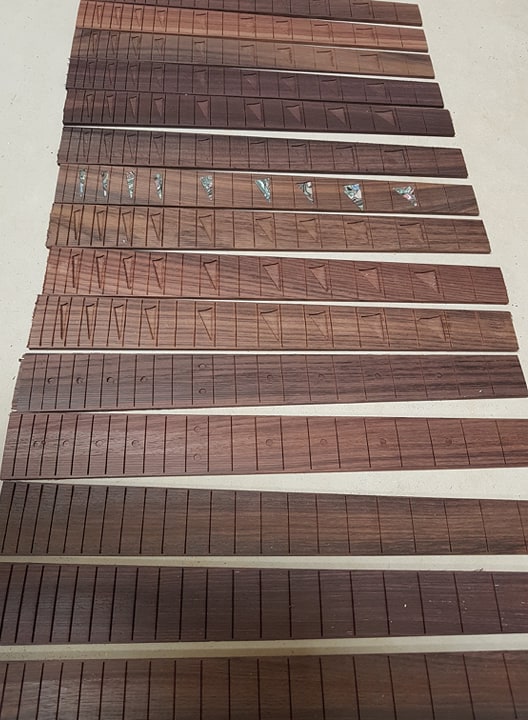Using a Computer Numerical Control unit (CNC) to control the operations from a router is often seen as not “authentic”. But the same could be said of other
- Accuracy – I can measure ten times and still be more accurate using a CNC. The thing is, once set up properly, the CNC will carry on doing the same operation to perfection every single time. And if you find a way to improve or refine a process, then the improvements can easily be implemented from the next run onwards. I can also do some virtual modeling and see how an item will look long before making the first cut.
- Blind Frets slots – Fret slots are not only in the right place time after time, but they are cut at a set depth that follows the curvature of the fingerboard, even if it is using a compound radius, making sure that the least amount of wood is removed. As a result, the frets once fitted have very little airspace underneath them which helps the integrity of the build and improves tone. Even better, I can stop cutting before the edge of the fingerboard and have the last bit of the fret tang seated in such a way as to eliminate sharp or popping fret ends. The feel is smooth and “worn in” and as the fret tang is invisible and the slot doesn’t go to the edge of the fingerboard, the slots are called “blind”. I’ll write a separate piece soon on “Fanned” or “Multiscale” fretboards, which are also much easier to achieve using a CNC.
- Compound Radius – The Fingerboards can have a variable radius, flattening out as you get up the board. This allows for better ( lower ) action as it reduces the risk of strings choking out as you bend them while playing
lead in the upper register. - Less Human Error – It is easy to underestimate how much difference applying simple pressure while hand guiding your router or workpiece makes. Using my old Pin Router I can get great results but the operator needs to know the jigs, the wood, and the machine to compensate for a lot of limitations and idiosyncrasies. I had the odd guitar body fly across the workshop too and it’s scary.
- More time for other tasks – As I am typing these words, I am currently machining 3 fingerboards blanks. There are numerous tool changes to be done and all going well, it will take roughly 3 to 4 hours to get the boards
radiussed , and cut to size, inlay pockets and fret slots cut. To be fair, you could probably do it by hand ( and by that, I meanhand controlled tools using jigsetc …) much, much, faster. But the result wouldn’t be as accurate and I wouldn’t be able to multitask.

Of course, using a CNC requires a new skill set.
Computer-Aided Design – I had to start learning more about CAD which was great as it allowed me to generate full-scale reference prints that are far superior to my old
Computer-Aided Manufacturing – Setting Speeds, depth of cuts, feed rates and fixtures and fittings to accommodate the CNC router is a totally different experience to using old fashioned hand tools or hand-guided tools.
The whole CAD-CAM learning curve led me eventually to using Aspire by Vectric Ltd. This brilliant British software company produces CAD/CAM programs that are suitable for all levels of users.
I have to confess that there are some drawbacks too. It can take longer, a lot longer, to machine a 3d curve with a small router bit than running a large shaper. But the advantages a soo huge that I wouldn’t want to be without mine.
I’m just off swapping the 12mm ball nose that shapes the fingerboard radius for the straight bit used to cut out the outline fretboard profile to finished size. Inlays and frets later on
Thanks for reading.



